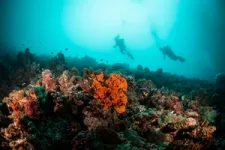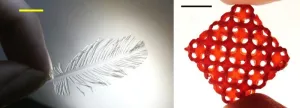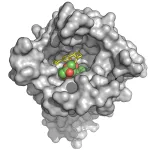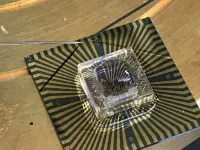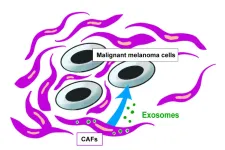(Press-News.org) INDIANAPOLIS, March 28, 2023 — Colorful particles of plastic drift along under the surface of most waterways, from headwater streams to the Arctic Ocean. These barely visible microplastics — less than 5 mm wide — are potentially harmful to aquatic animals and plants, as well as humans. So, researchers are devising ways to remove them and to stop them at their source. Today, a team reports a two-stage device made with steel tubes and pulsing sound waves that removes most of the plastic particles from real water samples.
The researchers will present their results at the spring meeting of the American Chemical Society (ACS). ACS Spring 2023 is a hybrid meeting being held virtually and in-person March 26–30, and features more than 10,000 presentations on a wide range of science topics.
“The idea came from a discussion with a colleague who said that we need new ways to collect microplastics from water,” says Menake Piyasena, Ph.D., the project’s principal investigator. “Because acoustic forces can push particles together, I wondered if we could use them to aggregate microplastics in water, making the plastic easier to remove.”
Filtration is the most commonly used technique for removing these materials from water. For example, washing machine outlet filters can keep fibers that slough off clothes during washing from entering wastewater. But this method can be costly on a large scale, requiring regular cleaning of the filters, which can get clogged.
Another option could be concentrating plastic particles in flowing water with acoustic forces, or sound waves, that transfer energy to nearby particles, causing some of them to vibrate and move. Just think of a speaker playing loud music that shakes the ground, bouncing flecks of dust and dirt toward each other. Scientists have already been using this phenomenon to separate biological particles from liquids, such as red blood cells from plasma.
Recently, some teams have applied this approach to the separation of microplastics from samples they prepared in the lab with pure water. But this work was done with tiny volumes of water. They also used microplastics that were only tens of microns wide — smaller than the width of human hair, explains Nelum Perera, a graduate student in Piyasena’s lab at New Mexico Tech.
“I read that most of the microplastics in the environment are larger than that,” says Perera, who is presenting the work. “So, I wanted to develop a device that could be useful for most of the sizes and could be scaled up to meet real-world goals.”
To accommodate higher water flow rates, Perera created a proof-of-concept device with 8-mm-wide steel tubes connected to one inlet tube and multiple outlet tubes. Then she attached a transducer to the metal tube’s side. When the transducer was turned on, it generated ultrasound waves across the metal tube, applying acoustic forces onto microplastics as they passed through the system, making them easier to capture. The prototype device is relatively simple compared to traditional filtration methods, Piyasena explains, because it doesn’t clog as easily as a filter.
In initial experiments with polystyrene, polyethylene and polymethyl methacrylate microplastics, the researchers discovered that smaller (6- to 180-µm-wide) particles behaved differently than the larger (180- to 300-µm-wide) ones in the presence of acoustic forces. Spiked into pure water, particles of both sizes arranged along the center of the channel, exiting through the middle outlet, while clean water flowed out the surrounding outlets. But if laundry detergent or fabric softener were added to the water, the larger particles focused toward the sides, exiting through the side outlets, and purified water out the middle outlet.
Based on these results, the researchers set out to develop a system that could take advantage of these differing movements. They connected two steel tubes in tandem: The first stage captured small microplastics less than 180 µm wide, and the water stream with the remaining larger microplastics went to the second stage to be cleaned. “We removed more than 70% of the small plastics and more than 82% of the large ones this way,” says Perera.
To show that the two-stage system could work for real-world applications, Perera and Piyasena collected water from a pond on the New Mexico Tech campus and from the Rio Grande River. They filtered all of the samples to remove large contaminants, leaving behind water that still contained dissolved substances that could have affected the separation. Next, they spiked the water with microplastics. When the environmental water samples went through the acoustics device, plastic particles were removed as effectively as from pure water. With this prototype, Perera estimates it would cost around 7 cents to operate the current device for an hour and take around an hour and a half to clean one liter of water.
The team’s next step is to develop a system with wider tubes, or bundles of multiple tubes, and to try it on unspiked real-world samples, including ocean water and wastewater from washing machines. “We have shown that acoustic forces can be used to concentrate a wide range of microplastic sizes,” says Piyasena. “And from here, we want to prove that this can be done on a larger scale with real samples that already have microplastics in them.”
The researchers do not cite a funding source for this research.
A recorded media briefing on this topic will be posted Tuesday, March 28, by 10 a.m. Eastern time at www.acs.org/acsspring2023briefings. Reporters can request access to media briefings during the embargo period by contacting newsroom@acs.org.
For health and safety information for ACS Spring 2023, please visit the FAQ webpage.
The American Chemical Society (ACS) is a nonprofit organization chartered by the U.S. Congress. ACS’ mission is to advance the broader chemistry enterprise and its practitioners for the benefit of Earth and all its people. The Society is a global leader in promoting excellence in science education and providing access to chemistry-related information and research through its multiple research solutions, peer-reviewed journals, scientific conferences, eBooks and weekly news periodical Chemical & Engineering News. ACS journals are among the most cited, most trusted and most read within the scientific literature; however, ACS itself does not conduct chemical research. As a leader in scientific information solutions, its CAS division partners with global innovators to accelerate breakthroughs by curating, connecting and analyzing the world’s scientific knowledge. ACS’ main offices are in Washington, D.C., and Columbus, Ohio.
To automatically receive news releases from the American Chemical Society, contact newsroom@acs.org.
Note to journalists: Please report that this research was presented at a meeting of the American Chemical Society.
Follow us: Twitter | Facebook | LinkedIn | Instagram
Title
Removal of environmentally relevant microplastics using acoustic forces and steel tubes
Abstract
A massive amount of plastic waste is released into the environment every year. These plastics degrade anthropogenically and naturally, resulting in fragments of plastics smaller than 5 mm in size, known as microplastics (MPs). The imminence levels of MPs accumulated in aquatic systems can pass into animal organs and cause health concerns, posting threats to life on earth. A broad range of sizes of MPs is found in the environment. Most MPs are large and suspended in aqueous media with different densities. Current MPs removal methods are ineffective for removing all MP sizes and types simultaneously, and they are not real-time or cost-effective. New isolation methods for MPs of varying sizes suspended in aqueous media with different densities must be explored to overcome these limitations. Acoustic forces can be used to manipulate particles suspended in aqueous media. Applying acoustic waves across a resonating chamber generates acoustic radiation forces on particles flowing through the chamber. These forces can focus particles onto different planes of the acoustic wave. In this presentation, we will discuss the development of acoustic devices made of steel tubes that can be used to remove various MP types and sizes suspended in aqueous media with varying densities. We will show the unique behavior of MPs of the same material yet different sizes in an applied acoustic field. We will also show the effect of medium density on particle focusing. Finally, we will discuss how we utilize these findings to design an acoustofluidic separation method to isolate the three most common MPs types in nature.
END
Pulsing ultrasound waves could someday remove microplastics from waterways
2023-03-28
ELSE PRESS RELEASES FROM THIS DATE:
Modern origami method creates glass shapes by folding
2023-03-28
INDIANAPOLIS, March 28, 2023 — The ancient art of origami is well known for transforming sheets of paper and other foldable materials into complex 3D shapes. But now, chemical engineers have extended the centuries-old practice to produce intricate shapes made of glass or other hard materials. Their thoroughly modern method, which can be combined with 3D printing, could have applications ranging from sculpture to catalysis and beyond.
The researchers will present their results today at the spring meeting of the American Chemical Society (ACS). ACS Spring 2023 is a hybrid meeting being held virtually and in-person ...
Marijuana-derived compounds could reverse opioid overdoses
2023-03-28
INDIANAPOLIS, March 28, 2023 — There’s been a recent push in the U.S. to make naloxone — a fast-acting opioid antidote — available without a prescription. This medication has saved lives, but it’s less effective against powerful synthetic opioids, such as fentanyl. In an interesting twist, researchers are now looking to cannabidiol (CBD), a component of marijuana, as a possible alternative to the popular antidote. Today, a team reports compounds based on CBD that reduce fentanyl binding and boost the effects of naloxone.
The researchers will present their results at the spring meeting of the American Chemical Society (ACS). ...
Is it COVID-19 or the flu? New sensor could tell you in 10 seconds
2023-03-28
INDIANAPOLIS, March 28, 2023 — Have a cough, sore throat and congestion? Any number of respiratory viruses could be responsible. Conventional tests can identify certain likely culprits by relying on chemical reactions, but some researchers want to swap chemistry for electrical changes sensed by nanomaterials. Today, scientists report using a single-atom-thick nanomaterial to build a device that can simultaneously detect the presence of the viruses that cause COVID-19 and the flu — at much lower levels and much more quickly than conventional tests for either.
The researchers will present their results at the spring meeting ...
Shedding pounds may benefit your heart — even if some weight is regained
2023-03-28
Research Highlights:
Weight loss was associated with decreased risk factors for cardiovascular disease and Type 2 diabetes for at least five years — even if some weight was regained, according to a review of research on behavioral weight loss programs.
People who lost weight through an intensive behavioral weight loss program had lower systolic blood pressure levels, total cholesterol-to-good cholesterol ratio and HbA1c levels (a diabetes marker), when compared to people who did not participate in a program or participated in a lower-intensity behavioral program.
Embargoed ...
Turtles and crocodiles with unique characteristics are more likely to go extinct
2023-03-28
New research led by the University of Oxford has revealed that the most endangered turtle and crocodile species are those that are most unique. Their loss could have widespread impacts on the ecosystems they live in, since they carry out critical processes important for many other species.
Turtles and crocodiles are two of the world's most endangered animal groups, with approximately half of species globally threatened (International Union for Conservation of Nature, IUCN). Greater understanding on which species are most threatened and why is urgently needed to inform conservation efforts to save them.
In a new study led by researchers at the Department of Biology, ...
A final present from birds killed in window collisions: poop that reveals their microbiomes
2023-03-28
Every year, millions of birds crash into windows in cities along their migratory path. For decades, scientists and volunteers have risen at dawn in spring and fall to collect the fallen birds, rehabilitating the injured and documenting the dead. The bodies of the birds killed in these collisions are a treasure trove of scientific information, especially when compared year after year. A new study in the journal Molecular Ecology makes use of these specimens to help understand the relationship between birds and the microbes living in their guts—which appears ...
ISTA welcomes first journalists in residence
2023-03-28
Understanding of and trust in science and scientists are dangerously low, and initial studies suggest that a general lack of interest in science is even more of a problem than skepticism in Austria. A key partner in alleviating this mistrust, clearing up misunderstandings, and building up enthusiasm for science must be the media in general and science journalists in particular. However, these journalists need access to the information as well as the resources to work independently and give full flight to their curiosity and creativity. To work towards these goals and promote excellent science journalism, ISTA initiated a program to host journalists for two-to-four-month ...
Candidate found to inhibit malignant melanoma growth
2023-03-28
Malignant melanoma is a relatively aggressive type of skin cancer. When detected early, it is usually treatable by surgical resection only, but metastases develop often spreading to distant areas. Currently, tumor thickness and the presence of ulceration are some of the known prognostic factors used as indicators of malignant melanoma. Therefore, the discovery of valuable markers to assess the malignant potential of melanoma more accurately may be necessary to develop appropriate treatments.
Cross talk between cancer cells and surrounding stromal cells is ...
New form of omega-3 could prevent visual decline with Alzheimer’s disease
2023-03-28
For the first time, researchers have developed a form of the omega-3 fatty acid docosahexaenoic acid (DHA) that is capable of crossing into the eye’s retina to ward off visual declines related to Alzheimer’s disease, diabetes and other disorders.
The DHA found in fish oil capsules and other supplements is typically in a form called triacylglycerol (TAG) DHA. Although TAG-DHA has benefits in other parts of the body, it does not reach the eyes because it cannot travel from the bloodstream into the retina. For the study, ...
Less ‘risky’ sex of early pandemic still evident year after first lockdown in Britain
2023-03-28
The lower prevalence of ‘risky’ sex—with multiple or new partners without using condoms—which occurred during the early stages of the COVID-19 pandemic, was still evident a year after Britain’s first lockdown, reveal the results of a major national survey, published online in the journal Sexually Transmitted Infections.
While there were fewer reported unplanned pregnancies and abortions than indicated by a comparable survey a decade earlier, there were significantly higher prevailing levels of sexual dissatisfaction and worries ...


